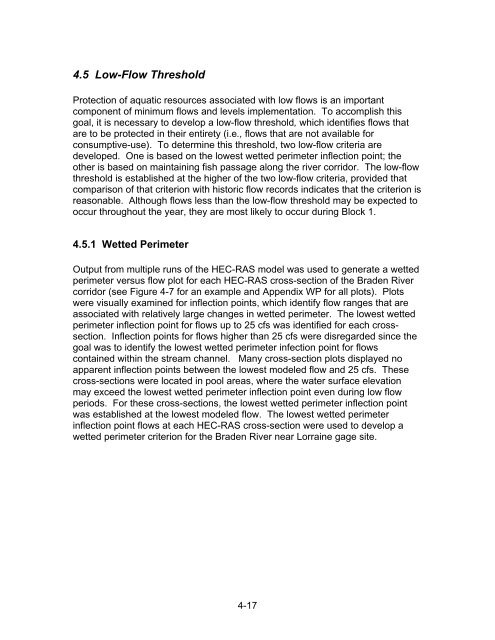Chapter 1 Minimum Flows and Levels - Southwest Florida Water ...
Chapter 1 Minimum Flows and Levels - Southwest Florida Water ...
Chapter 1 Minimum Flows and Levels - Southwest Florida Water ...
You also want an ePaper? Increase the reach of your titles
YUMPU automatically turns print PDFs into web optimized ePapers that Google loves.
4.5 Low-Flow Threshold<br />
Protection of aquatic resources associated with low flows is an important<br />
component of minimum flows <strong>and</strong> levels implementation. To accomplish this<br />
goal, it is necessary to develop a low-flow threshold, which identifies flows that<br />
are to be protected in their entirety (i.e., flows that are not available for<br />
consumptive-use). To determine this threshold, two low-flow criteria are<br />
developed. One is based on the lowest wetted perimeter inflection point; the<br />
other is based on maintaining fish passage along the river corridor. The low-flow<br />
threshold is established at the higher of the two low-flow criteria, provided that<br />
comparison of that criterion with historic flow records indicates that the criterion is<br />
reasonable. Although flows less than the low-flow threshold may be expected to<br />
occur throughout the year, they are most likely to occur during Block 1.<br />
4.5.1 Wetted Perimeter<br />
Output from multiple runs of the HEC-RAS model was used to generate a wetted<br />
perimeter versus flow plot for each HEC-RAS cross-section of the Braden River<br />
corridor (see Figure 4-7 for an example <strong>and</strong> Appendix WP for all plots). Plots<br />
were visually examined for inflection points, which identify flow ranges that are<br />
associated with relatively large changes in wetted perimeter. The lowest wetted<br />
perimeter inflection point for flows up to 25 cfs was identified for each crosssection.<br />
Inflection points for flows higher than 25 cfs were disregarded since the<br />
goal was to identify the lowest wetted perimeter infection point for flows<br />
contained within the stream channel. Many cross-section plots displayed no<br />
apparent inflection points between the lowest modeled flow <strong>and</strong> 25 cfs. These<br />
cross-sections were located in pool areas, where the water surface elevation<br />
may exceed the lowest wetted perimeter inflection point even during low flow<br />
periods. For these cross-sections, the lowest wetted perimeter inflection point<br />
was established at the lowest modeled flow. The lowest wetted perimeter<br />
inflection point flows at each HEC-RAS cross-section were used to develop a<br />
wetted perimeter criterion for the Braden River near Lorraine gage site.<br />
4-17
















